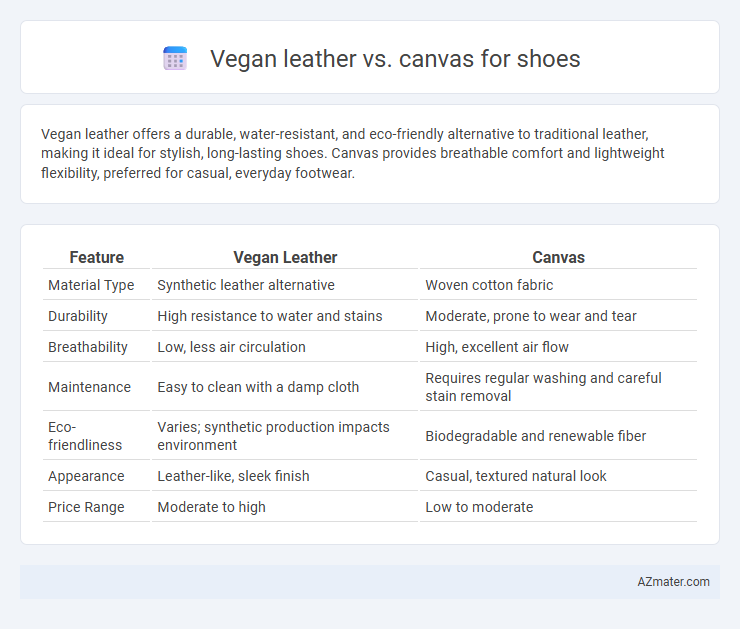Vegan leather offers a durable, water-resistant, and eco-friendly alternative to traditional leather, making it ideal for stylish, long-lasting shoes. Canvas provides breathable comfort and lightweight flexibility, preferred for casual, everyday footwear.
Table of Comparison
| Feature | Vegan Leather | Canvas |
|---|---|---|
| Material Type | Synthetic leather alternative | Woven cotton fabric |
| Durability | High resistance to water and stains | Moderate, prone to wear and tear |
| Breathability | Low, less air circulation | High, excellent air flow |
| Maintenance | Easy to clean with a damp cloth | Requires regular washing and careful stain removal |
| Eco-friendliness | Varies; synthetic production impacts environment | Biodegradable and renewable fiber |
| Appearance | Leather-like, sleek finish | Casual, textured natural look |
| Price Range | Moderate to high | Low to moderate |
Introduction to Vegan Leather and Canvas Shoes
Vegan leather offers a sustainable, animal-free alternative to traditional leather, made from materials like polyurethane or plant-based fibers, providing durability and a sleek finish ideal for fashion-forward shoes. Canvas shoes, crafted from woven cotton or linen, are lightweight, breathable, and highly versatile, making them a popular choice for casual and sporty footwear. Both materials present eco-conscious options, with vegan leather emphasizing longevity and style, while canvas prioritizes comfort and breathability in shoe design.
Material Composition: Vegan Leather vs Canvas
Vegan leather is a synthetic material typically made from polyurethane (PU) or polyvinyl chloride (PVC), designed to mimic the texture and durability of animal leather while being cruelty-free and water-resistant. Canvas, composed of woven cotton or linen fibers, offers breathability and flexibility but tends to absorb moisture and wear faster under harsh conditions. The choice between vegan leather and canvas hinges on preferred material properties such as durability, maintenance, and environmental impact.
Environmental Impact Comparison
Vegan leather, typically made from polyurethane or plant-based materials like pineapple leaves or apple peels, often has a lower carbon footprint and water usage compared to traditional leather but can still involve synthetic chemicals that impact the environment. Canvas shoes, primarily crafted from cotton, require significant water and pesticide inputs during cotton cultivation, contributing to higher environmental degradation and resource consumption. Choosing sustainably sourced organic cotton canvas or innovative plant-based vegan leather alternatives can further reduce the ecological footprint of footwear production.
Durability and Lifespan
Vegan leather offers moderate durability with resistance to water and stains but may crack or peel over time, especially under heavy use. Canvas, known for its breathability and flexibility, provides high durability with proper care yet is more susceptible to wear and tear from moisture and abrasion. Choosing between vegan leather and canvas depends on the intended use, with vegan leather suitable for stylish, low-maintenance shoes and canvas excelling in casual, long-lasting footwear.
Comfort and Breathability
Vegan leather offers a sleek, water-resistant surface but tends to have lower breathability compared to canvas, which allows better airflow and moisture absorption, enhancing comfort during prolonged wear. Canvas shoes are lightweight and flexible, contributing to superior ventilation and reducing foot sweat, making them ideal for warm climates or active use. While vegan leather provides durability and easy maintenance, canvas excels in comfort and breathability, accommodating natural foot movement and temperature regulation.
Maintenance and Cleaning
Vegan leather shoes require gentle cleaning with a damp cloth and mild soap, avoiding harsh chemicals to maintain their texture and prevent cracking. Canvas shoes are more durable for frequent washes and can be cleaned using a brush and soapy water, making them ideal for heavy-duty use and outdoor activities. Both materials benefit from air drying and regular maintenance to extend their lifespan and preserve appearance.
Style and Aesthetic Options
Vegan leather offers a sleek, polished look with a variety of textures and finishes that mimic genuine leather, providing a sophisticated aesthetic ideal for formal or stylish footwear. Canvas shoes present a casual, versatile appeal with customizable prints and color options, perfect for everyday wear and expressive designs. Both materials allow for diverse style choices, but vegan leather emphasizes elegance while canvas prioritizes comfort and creativity.
Cost and Affordability
Vegan leather shoes typically cost more than canvas options due to synthetic material production and manufacturing processes. Canvas shoes offer greater affordability with prices often 30-50% lower, appealing to budget-conscious consumers. Long-term cost efficiency also favors canvas, as it generally requires less maintenance and can be more durable in casual wear.
Ethical Considerations
Vegan leather offers a cruelty-free alternative to traditional leather, reducing animal exploitation and aligning with ethical consumer values. Canvas shoes provide a sustainable option when made from organic or recycled fibers, minimizing environmental impact through lower water usage and biodegradability. Both materials present ethical benefits, but vegan leather's avoidance of animal products and canvas's environmental advantages appeal to conscientious buyers seeking responsible footwear choices.
Which Material is Better for Shoes?
Vegan leather offers a sleek, water-resistant, and durable surface ideal for fashion-forward shoes, while canvas provides superior breathability and flexibility, making it better suited for casual, lightweight footwear. The choice depends on use: vegan leather excels in formal and weather-resistant shoes, whereas canvas is preferred for comfort and air circulation in everyday sneakers. Both materials contribute to sustainability, with vegan leather often being animal-friendly and canvas commonly made from natural fibers like cotton.

Infographic: Vegan leather vs Canvas for Shoe
 azmater.com
azmater.com